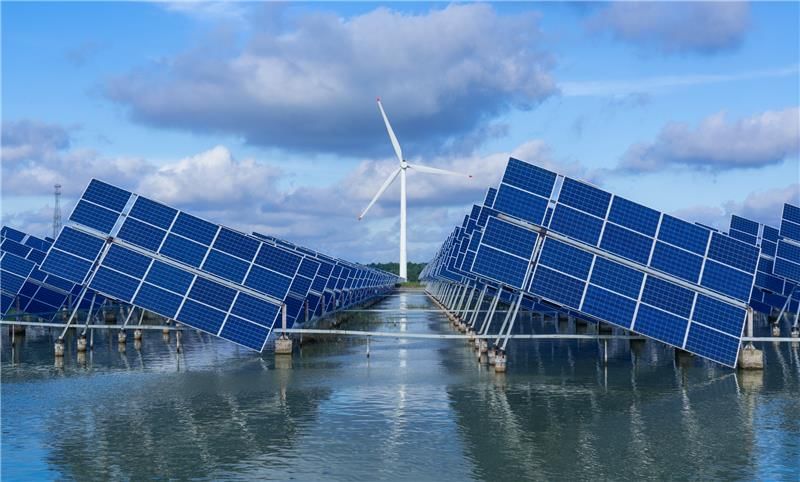Abu Dhabi, UAE — Renewables maintain their cost leadership in global power markets, IRENA’s new report on Renewable Power Generation Costs in 2024 confirms.
The report confirms that renewables maintained their price advantage over fossil fuels, with cost declines driven by technological innovation, competitive supply chains, and economies of scale.
In 2024, solar photovoltaics (PV) were, on average, 41 percent cheaper than the lowest-cost fossil fuel alternatives, while onshore wind projects were 53 percent cheaper. Onshore wind remained the most affordable source of new renewable electricity at US$0.034/kWh, followed by solar PV at US$ 0.043/kWh.
The addition of 582 gigawatts of renewable capacity in 2024 led to significant cost savings, avoiding fossil fuel use valued at about US$57 billion. Notably, 91 percent of new renewable power projects commissioned last year were more cost-effective than any new fossil fuel alternatives.
Renewables are not only cost-competitive vis-a-vis fossil fuels but are advantageous by limiting dependence on international fuel markets and improving energy security. The business case for renewables is now stronger than ever.
While continued cost reductions are expected as technologies mature and supply chains strengthen, short-term challenges remain. Geopolitical shifts including trade tariffs, raw material bottlenecks, and evolving manufacturing dynamics, particularly in China, pose risks that could temporarily raise costs.
Higher costs are likely to persist in Europe and North America, driven by structural challenges such as permitting delays, limited grid capacity, and higher balance-of-system expenses.
In contrast, regions like Asia, Africa, and South America, with stronger learning rates and high renewable potential, could see pronounced cost declines.
United Nations Secretary-General António Guterres said, “Clean energy is smart economics – and the world is following the money. Renewables are rising, the fossil fuel age is crumbling, but leaders must unblock barriers, build confidence, and unleash finance and investment. Renewables are lighting the way to a world of affordable, abundant, and secure power for all.”
IRENA Director-General Francesco La Camera added, “The cost-competitiveness of renewables is today’s reality. Looking at all renewables currently in operation, the avoided fossil fuel costs in 2024 reached up to US$ 467 billion. New renewable power outcompetes fossil fuels on cost, offering a clear path to affordable, secure, and sustainable energy. This achievement is the result of years of innovation, policy direction, and growing markets. However, this progress is not guaranteed. Rising geopolitical tensions, trade tariffs, and material supply constraints threaten to slow the momentum and drive-up costs. To safeguard the gains of the energy transition, we must reinforce international cooperation, secure open and resilient supply chains, and create stable policy and investment frameworks—especially in the Global South. The transition to renewables is irreversible, but its pace and fairness depend on the choices we make today.”
IRENA’s 2024 report also explores the structural cost drivers and market conditions shaping renewable investment. It concludes that stable and predictable revenue frameworks are essential to reduce investment risk and attract capital.
Mitigating financing risk is central to scaling renewables in both mature and emerging markets. Instruments such as power purchase agreements (PPAs) play a pivotal role in accessing affordable finance, while inconsistent policy environments and opaque procurement processes undermine investor confidence.
Particularly, integration costs are emerging as a new constraint on deployment of renewables. Increasingly, wind and solar projects are delayed due to grid connection bottlenecks, slow permitting and costly local supply chains. This is acute in G20 and emerging markets, where grid investment must keep pace with rising electricity demand and the expansion of renewables.
Furthermore, financing costs remain a decisive factor in determining project viability. In many developing countries of the Global South, high capital costs, influenced by macroeconomic conditions and perceived investment risks, significantly inflate the levelized cost of electricity (LCOE) of renewables.
For example, IRENA found that while onshore wind generation costs were similar in Europe and Africa with around US$0.052/kWh in 2024, the cost structures varied significantly. European projects were capital-expenditure driven, while African projects bore a much higher share of financing costs. IRENA’s assumed cost of capital ranged from 3.8 percent in Europe to 12 percent in Africa, reflecting differing perceived risk profiles.
Finally, technological advances beyond generation are also improving the economics of renewables. The cost of battery energy storage systems (BESS) has declined by 93 percent since 2010, reaching US$192/kWh for utility-scale systems in 2024. This reduction is attributed to manufacturing scale-up, improved materials and optimized production techniques.
Battery storage, hybrid systems, combining solar, wind and BESS as well as digital technologies are increasingly vital for integrating variable renewable energy.
Artificial intelligence (AI)-enabled digital tools are enhancing asset performance and grid responsiveness. However, digital infrastructure, flexibility, and grid expansion and modernization remain pressing challenges, including in emerging markets, where the full potential of renewables cannot be realized without further investment.








